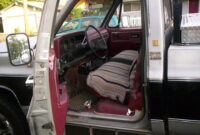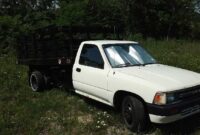1980 Chevy Pickup Trucks For Sale: Your Comprehensive Buyer’s Guide pickup.truckstrend.com
The year 1980 marks a sweet spot in the annals of American automotive history, especially for pickup truck enthusiasts. Nestled firmly within the iconic "Square Body" generation (1973-1987), the 1980 Chevy pickup truck represents a unique blend of rugged utility, timeless design, and increasing collectibility. For those on the hunt for a classic vehicle that offers both nostalgic appeal and practical versatility, a 1980 Chevy truck for sale can be an incredibly rewarding find. This article serves as your comprehensive guide to understanding, locating, and ultimately acquiring one of these legendary workhorses, whether you’re seeking a pristine show truck, a reliable daily driver, or a rewarding restoration project.
The Enduring Appeal of the 1980 Chevy Pickup
1980 Chevy Pickup Trucks For Sale: Your Comprehensive Buyer’s Guide
What makes the 1980 Chevy pickup, specifically, so desirable? Part of its allure lies in its distinctive, no-nonsense "Square Body" aesthetic. Its clean lines, robust stance, and straightforward design exude an undeniable charm that modern trucks often lack. Beyond aesthetics, these trucks were built during an era when durability and ease of maintenance were paramount. They are renowned for their robust frames, relatively simple mechanical systems, and a vast availability of aftermarket parts, making them ideal for both seasoned mechanics and DIY enthusiasts. For many, owning a 1980 Chevy pickup is a journey back in time, a tangible piece of Americana that evokes memories of simpler days, hard work, and open roads. Its versatility means it can serve as a dependable hauler, a weekend cruiser, or a show-stopping custom build.
Understanding the 1980 C/K Series: Models and Trims
To effectively search for a 1980 Chevy pickup, it’s crucial to understand the nomenclature of the era. Chevrolet’s full-size pickups were part of the C/K series:
- C-Series: Denoted 2-wheel-drive models.
- K-Series: Denoted 4-wheel-drive models.
Within these series, weight classes and configurations were identified:

- 10 (or 1500): Half-ton capacity.
- 20 (or 2500): Three-quarter-ton capacity.
- 30 (or 3500): One-ton capacity.

So, a "C10" would be a 2WD half-ton, while a "K20" would be a 4WD three-quarter-ton.
Body styles included:
- Regular Cab: The most common, available with short or long beds.
- Extended Cab (Bonus Cab/Club Cab): Offered limited rear seating or storage.
- Crew Cab: Full four-door configuration, less common but highly sought after, especially in 4WD.

Trim levels in 1980 offered varying levels of comfort and amenities:
- Custom Deluxe: The base model, no-frills work truck.
- Scottsdale: A step up, offering more interior comforts and exterior trim.
- Cheyenne: Further enhancements, including chrome trim, improved seating, and potentially more power options.
- Silverado: The top-tier luxury trim, featuring plush interiors, extensive chrome, and often power accessories like windows and locks.
Engine options were varied, including the dependable 250 cubic inch inline-six, and a range of V8s such as the 305, 350, and the powerful 454 cubic inch big block. Diesel options (like the 6.2L) would become more common later in the Square Body run but were less prevalent in 1980.
What to Look For When Buying a 1980 Chevy Pickup
Purchasing a classic vehicle requires diligence. Here’s a breakdown of critical areas to inspect:
Rust and Body Condition
This is often the primary killer of Square Bodies. Common rust areas include:
- Cab Corners and Rocker Panels: Look inside the door jambs and along the lower edges of the cab.
- Fenders and Wheel Wells: Especially around the tire openings.
- Bed Floor and Inner Fenders: Pay close attention to the front of the bed where it meets the cab, and inside the wheel wells.
- Frame: While generally robust, check for pitting, cracks, or previous repair attempts, particularly around suspension mounting points.
- Windshield and Rear Window Seals: Leaks here can lead to floor pan rust.
Engine and Drivetrain
- Engine: Check for leaks (oil, coolant), unusual noises (knocks, rattles), excessive smoke from the exhaust (blue for oil, white for coolant, black for rich fuel). Ensure it starts easily and idles smoothly.
- Transmission: For automatics, check fluid color and smell (should be red, not burnt). Test all gears, including reverse, for smooth engagement. For manuals, check clutch feel, gear engagement, and listen for grinding.
- 4×4 System (if applicable): Engage 4-high and 4-low. Listen for clunks or binding. Check front axle and transfer case for leaks.
Suspension, Steering, and Brakes
- Suspension: Look for sagging, especially if it’s been used for heavy hauling. Check shocks, springs, and bushings for wear.
- Steering: Test for excessive play in the steering wheel. Check tie rods, ball joints, and the power steering pump.
- Brakes: Ensure firm pedal feel and no pulling during braking. Check for leaks in lines or calipers/wheel cylinders.
Interior Condition
- Seats and Upholstery: Look for rips, tears, and overall wear.
- Dashboard: Check for cracks, especially common in older vehicles.
- Gauges and Electrical: Ensure all gauges work, as do lights, wipers, horn, heater/AC (if equipped), and power windows/locks.
- Flooring: Lift mats to check for rust or water damage.
Documentation
Always request the title to ensure it’s clean and matches the VIN. Any maintenance records, even partial, can provide valuable insight into the truck’s history.
Where to Find 1980 Chevy Pickups For Sale
The market for classic trucks is vibrant, offering several avenues for your search:
- Online Marketplaces: Websites like eBay Motors, Craigslist, Facebook Marketplace, and dedicated classic car sites (e.g., ClassicCars.com, Hemmings, Bring a Trailer) are excellent resources. Be prepared to filter by year and model.
- Specialty Forums and Clubs: Online forums dedicated to Square Body trucks often have "for sale" sections. These communities can also offer valuable advice.
- Auctions: Classic car auctions (Mecum, Barrett-Jackson) occasionally feature well-restored examples, while local auctions might turn up project trucks.
- Local Classifieds and Word-of-Mouth: Don’t underestimate the power of local listings or simply asking around. Many great finds come from private sellers who aren’t tech-savvy.
- Classic Car Dealerships: These dealers often have a selection of vetted classic vehicles, though prices may be higher to account for their overhead and preparation.
Restoration vs. Driver vs. Project: Setting Expectations
Before you buy, decide what kind of truck you’re looking for, as this significantly impacts price and effort:
- Project Truck: These are typically non-running or in very rough condition, requiring extensive work. They are the most affordable but demand significant time, money, and skill. Ideal for those who love to wrench.
- Driver Quality: These trucks are running and roadworthy, but will have cosmetic flaws, minor mechanical issues, or need general maintenance. They offer a great starting point for incremental improvements and can be enjoyed immediately.
- Good Condition/Survivor: Well-maintained trucks that are largely original, show minimal wear, and are ready to be enjoyed with little immediate work. These command higher prices.
- Show Quality/Restored: These have undergone professional, often frame-off, restorations. They are in pristine condition, often better than new, and come with a premium price tag. Ideal for collectors or those who want a turn-key classic.
Tips for a Successful Purchase
- Set a Realistic Budget: Beyond the purchase price, factor in potential repairs, insurance, registration, and transportation costs.
- Pre-Purchase Inspection (PPI): If possible, have an independent mechanic specializing in classic vehicles inspect the truck. This is invaluable for identifying hidden issues.
- Test Drive: Always test drive the truck. Pay attention to how it starts, accelerates, brakes, and handles. Listen for unusual noises.
- Research Pricing: Look at recently sold comparable trucks to get a realistic sense of market value based on condition, trim, and configuration.
- Be Patient: The right truck might not appear overnight. Don’t rush into a purchase.
Potential Challenges and Solutions
- Parts Availability: While generally good, specific trim pieces or unique parts for earlier Square Bodies can be harder to find. Solution: Join online forums, connect with parts suppliers, and consider used parts from salvage yards.
- Finding Skilled Mechanics: Not all modern shops are equipped or willing to work on older vehicles. Solution: Seek out independent shops specializing in classics or hot rods. Learn to do some repairs yourself.
- Unexpected Repairs: Older vehicles can always spring surprises. Solution: Allocate a contingency fund for unforeseen issues.
- Insurance: Standard insurance might not cover the true value of a classic. Solution: Look into specialized classic car insurance providers that offer agreed-value policies.
1980 Chevy Pickup Trucks For Sale: Estimated Price Guide
Prices for 1980 Chevy pickups can vary wildly based on condition, trim level, engine, 2WD/4WD, and geographic location. The table below provides a general range.
| Condition Category | Description | Estimated Price Range (USD) |
|---|---|---|
| Project/Parts Truck | Non-running, significant rust, major mechanical/cosmetic issues. | $1,500 – $5,000 |
| Driver Quality | Running, roadworthy, some rust/dents, minor mechanical needs, worn interior. | $6,000 – $15,000 |
| Good Condition/Survivor | Running strong, minimal rust, solid body, clean interior, well-maintained. | $16,000 – $30,000 |
| Show Quality/Restored | Frame-off restoration, pristine condition, period-correct or high-end custom. | $35,000 – $70,000+ |
Note: These are general estimates. Rare configurations (e.g., K30 Crew Cab, original big-block trucks) or highly customized builds can command significantly higher prices.
Frequently Asked Questions (FAQ)
Q1: Are parts for 1980 Chevy pickups readily available?
A1: Yes, generally. Due to the long production run of the Square Body generation (1973-1987) and their popularity, mechanical parts (engine, transmission, suspension, brakes) are widely available new from aftermarket suppliers. Body panels and interior trim pieces can sometimes be more challenging, but used parts and reproduction pieces are often found.
Q2: What kind of fuel economy can I expect?
A2: Don’t expect modern fuel economy. Depending on the engine (V8s especially) and transmission, expect anywhere from 8-15 miles per gallon (MPG). The inline-six engines typically offer slightly better economy.
Q3: Can a 1980 Chevy pickup be a reliable daily driver?
A3: Absolutely, with proper maintenance and potentially some upgrades. Many enthusiasts use them as daily drivers. Regular maintenance is key, and modern upgrades like electronic ignition, fuel injection, or improved braking can enhance reliability and safety.
Q4: How much does it cost to insure a classic truck like this?
A4: Insurance costs vary, but often classic car insurance policies are surprisingly affordable, sometimes less than modern car insurance, especially if the vehicle is not a daily driver. Companies like Hagerty or American Collectors Insurance specialize in agreed-value policies for classics.
Q5: Are 1980 Chevy pickups easy to customize?
A5: Yes, they are a favorite platform for customization. Their simple design, robust frame, and vast aftermarket support make them ideal for engine swaps, suspension lifts or drops, interior upgrades, and custom paint jobs.
Q6: What are the common issues to watch out for besides rust?
A6: Beyond rust, common issues can include worn steering components, aging wiring (especially if not maintained), vacuum leaks affecting engine performance, and general wear on suspension bushings and shocks.
Conclusion
The 1980 Chevy pickup truck stands as a testament to American automotive design and engineering – a durable, stylish, and highly versatile vehicle that continues to capture the hearts of enthusiasts. Whether you’re drawn to its iconic "Square Body" aesthetics, its straightforward mechanical simplicity, or its potential as a canvas for customization, acquiring one of these trucks can be a deeply rewarding experience. By understanding the different models, knowing what to inspect, exploring various purchasing avenues, and setting realistic expectations, you can navigate the market with confidence. The journey of finding and owning a 1980 Chevy pickup is more than just a transaction; it’s an investment in a piece of history, a commitment to a classic, and the beginning of countless new adventures on the open road. Happy hunting!



